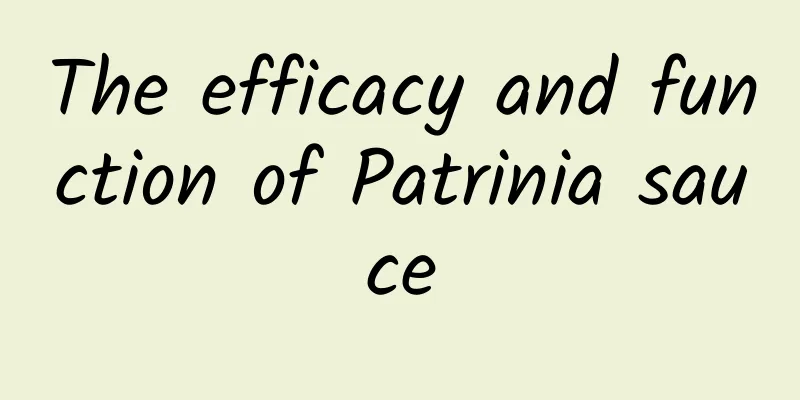The efficacy and function of Patrinia sauce

|
Traditional Chinese medicine culture is profound and extensive, and Chinese medicinal materials account for a large proportion of it. Do you know about Baijiang? What are its effects and functions, and how to eat it? I believe many people are very interested in it. Let me tell you one by one below. [Other names] Deer intestines (Ben Jing), deer head, horse grass, zebai (Bielu), deer sauce (Yao Xing Lun), sour benefit (Rihuazi Materia Medica), bitter vegetable, bitter radish (Compendium of Materia Medica), wild bitter vegetable (Illustrated Catalogue of Plant Names and Realities), bitter pig vegetable (Jiangxi Chinese Medicine), bitter monkshood (Sichuan Chinese Medicine Records), bean curd grass, bean curd grass (Chongqing Herbal Medicine), white bitter dad, bitter radish (Mindong Materia Medica). [Source] It is the whole herb with roots of Patrinia leucoderma , Patrinia yew or their closely related plants of the Patrinaceae family. It is usually harvested in summer. The whole plant is pulled up, the mud and sand are removed, and then it is dried. [Original form] ① Patrinia odorata, also known as: Rouge hemp. [Habitat distribution] Produced in Sichuan, Jiangxi, Fujian and other places. [Properties] The dried whole plant of Patrinia leucoderma is of varying lengths; the rhizome has nodes and bears fine whisker-like roots. The stem is cylindrical, yellow-brown or yellow-green in appearance, with longitudinal texture and covered with coarse hairs. It is brittle, easy to break, hollow in cross section, and white in color. The leaves are mostly wrinkled, broken, or have fallen off. The whole plant has a stale bean paste smell and tastes bitter. The best ones are dry, have many leaves, strong aroma, and are free of mud, sand, and weeds. [Chemical composition] Patrinia dahurica contains volatile oil, and the dried fruit branches contain sinigrin, etc. The roots and rhizomes contain honeysuckle glycosides, strychnosin, and patula glycosides. 【Nature and flavor】 Bitter, neutral. [entry into meridians] Enters the liver, stomach and large intestine meridians. 【Functions and indications】 Clears away heat, detoxifies, discharges pus and removes blood stasis. It is used to treat intestinal abscesses, diarrhea, leucorrhea, abdominal pain due to blood stasis after childbirth, red and swollen eyes, carbuncle, scabies and tinea. [Usage and Dosage] For oral use: decocted in water, 3-5 qian (2-4 liang for fresh ones). For external use: mash and apply. 【Note】 "Compendium of Materia Medica" says: "People with long-term illness, weak stomach, diarrhea and loss of appetite, and all other diseases caused by cold and weakness should avoid it." [Additional prescription] ① To treat intestinal abscess, with scales on the body, tight skin on the abdomen, and a soft swelling when pressed. There is no accumulation in the abdomen, and the body is not hot. The pulse is rapid. This is due to abscess and pus in the intestine: 10 parts coix seed, 2 parts aconite, and 5 parts Pueraria lobata. Grind the above three ingredients into powder. Take a spoonful of powder, add two liters of water, boil it until it is reduced by half, and drink it all at once. It will disappear immediately through urination. (Coix, Aconite and Baijiang Powder from "Golden Chamber") 【Discussions by various scholars】 ① "Compendium of Materia Medica": "Baijing is good at expelling pus and breaking blood, so Zhang Zhongjing used it to treat carbuncle, and ancient prescriptions for gynecology all used it. It is an easy-to-obtain ingredient, but later generations did not know how to use it, probably because they had not met anyone who knew how to use it." [Clinical application] Treatment of mumps: Take an appropriate amount of fresh leaves of Patrinia scabra, add 0.5-1 liang of gypsum, mash them together, then mix with 1 duck egg white, apply to the swollen and painful area, and remove after 24 hours. In severe cases, apply twice. Patients with complications can take 20-50% decoction of Patrinia scabra, 3-4 times a day, 20-30 ml each time; or drink it as tea. More than 200 cases were treated, and 90% of the cases had symptoms disappear within 24 hours after local application of the medicine. The general symptoms of patients with severe cases (including those with complications of orchitis) also disappeared after the second application of the medicine. In addition, this product is also effective for furuncle, carbuncle, mastitis, lymphangitis, etc. [Remarks] According to the "Compendium of Materia Medica", Baijiang should be the above-mentioned Baijiang family plants, but except for Sichuan, Jiangxi, Anhui, Fujian and other places, most areas are accustomed to using the whole herb with roots of the Asteraceae plant Sonchus endive and the whole herb with fruits of the Cruciferae plant Imbricata as Baijiang. The former is commonly used in the north; the latter is commonly used in the south. See the entries for "Lactuca indica" and "Lactuca indica". 【Excerpt】 《*Dictionary》 [Source] From "Shennong's Herbal Classic". Through the detailed introduction of Baijiang, I believe everyone has a certain understanding and can better improve our common sense in life. |
<<: The efficacy and function of sorghum bubble
>>: The efficacy and function of sorghum leaves
Recommend
The efficacy and function of Hehecao
Hehecao is a medicinal herb. If we have some unde...
The efficacy and function of white flower vine
The development of Western medicine has brought s...
After the Big Bang, there was another Dark Bang…
This is a picture of the galaxy cluster Cl0024+16...
What if there is a black hole at the center of the sun? Astronomers are really studying it!
First of all, let me make it clear that this is n...
The efficacy and function of Ligustrum lucidum
Modern medical research believes that Alpinia off...
The high-definition schematic diagram of the Chinese space station is here! Common terminology knowledge post for manned space flight, it is recommended to collect
With the safe return of the three astronauts Zhai...
Learn more about the names of naval vessels! Fujian, Liaoning... What are the rules for naming naval vessels?
In Fuzhou, you can see the earliest ship design a...
Why are there more and more patients with cerebral infarction? These are the high-risk factors
Stroke, or more accurately, cerebral infarction ,...
What are the side effects of the traditional Chinese medicine Astragalus?
Astragalus is a very common Chinese herbal medici...
The efficacy and function of Ulva
Chinese medicinal materials are very common, and ...
Anyone can get tuberculosis? Blame this stubborn household!
Mixed Knowledge Specially designed to cure confus...
What is the "Sky Eye" looking at? Could it have received alien signals?
Guizhou Sky Eye is the nickname of the 500-meter ...
No kidding, Corgis are really cattle dogs!
Corgis are petite and cute, and when you see them...
Who can't eat dandelions?
Dandelion flower is a very common plant in nature...
Mushrooms growing on apples and garlic? A doctor from the Chinese Academy of Sciences bought and tasted them...
Edit: April Last month Zhejiang continues to expe...









